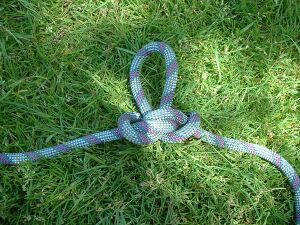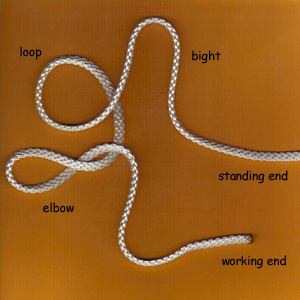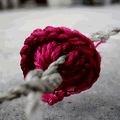
A knot is a method for fastening or securing linear material such as rope by tying or interweaving. See the articles/galleries below for instructions on tying various types of knots, and see wikipedia:Knot for more information.
Components[edit | edit source]
- Hitch: A knot used to attach a rope to a fixed object.

- Bight
- The center part of a length of rop as opposed to the ends.
- A bight: is any portion of the rope, string, or yarn between its two ends.
- The bight: is a U-shaped loop used in making a knot or stitch. Many knots, such as the Bowline can be tied in either the end or the bight.
- Elbow
- Two crossing points created by an extra twist in a loop.
- Loop
- A full circle formed by passing the working end over itself.
- Bend
- A knot uniting two lines often joining two ends of rope together.
- Decorative
- A knot exhibiting patterns, often binding to itself, and is neato.
Notes[edit | edit source]
- Different knots have different applications.
- A rope containing a knot is weaker than an unknotted rope, because the loops of the knot impose uneven stresses upon the rope fibers. The tighter the knot, the more uneven the stress.
Galleries[edit | edit source]
These galleries are listed individualy in the articles section below. These galleries may eventually become to numerous, in which case only galleries in articles will be linked.
Figure Eight[edit | edit source]
Figure Eight on a bight[edit | edit source]
Bowline[edit | edit source]
Bowline one more time[edit | edit source]
Butterfly or Harness loop[edit | edit source]
Double Fisherman's[edit | edit source]
Clove Hitch[edit | edit source]
Truckers Hitch[edit | edit source]
Knots for the Rope Pump[edit | edit source]
Why[edit | edit source]
The 'washers' on the rope-pump need to be made from a material that is cheap and easily available. They also need to be easily repairable or replaceable. This is neseccary when whashers crack off or wear over time. Another priority is to have the 'washers' made from a material and in such a way that their construction and repair can and will be done by women. This is because it is usually the women's task to collect water, and so the water pumps will be mainly used by women. The design of the 'washer' should therefore be a design that is 'appropriate for women'. The 'washer' should fit into the pump pipe loosely; it needs to be securely attached to the pump rope and it needs to have a system of construction that is simple and easy to explain and learn.
How[edit | edit source]
To make rope elements, one to two meters long and ending in a knot that loosely fits the pipe is an alternative for rubber or plastic washers slid over the pump rope or knots made at intervals in the pump rope . It would be women's work to make such rope elements in a handicraft way like Macramé. When hauling water, women can keep track of the wear of such rope elements and replace one element when necessary. This replacement can be done in a few minutes, there is no need to take the pump out of service. The picture shows a complex piece of macrame work. In a similar way the rope emement should be made: thin rope, woven into a sting, a loop at one end and a thick knot at hte other end. Each loop can be attached to the knot of the next rope element by inserting it into an opening in the knot. There the loop can be fastened.














































































